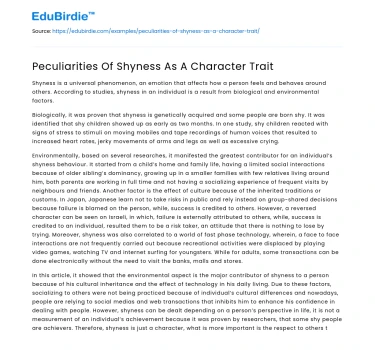Introduction
Shyness is a complex character trait that manifests differently across individuals and situations. As a psychological construct, shyness has intrigued researchers and psychologists for decades, leading to numerous studies aimed at unraveling its peculiarities. Defined generally as discomfort or inhibition in social situations, shyness is often perceived as a negative attribute. However, it can also be seen as a nuanced and multifaceted trait that reflects a deeper sensitivity to one's environment. This essay explores the peculiarities of shyness, examining its causes, its impact on personal and social dynamics, and the common misconceptions surrounding it. By analyzing real-life cases and scholarly sources, this essay aims to present a comprehensive view of shyness as a character trait, challenging conventional perceptions and highlighting its potential advantages and disadvantages.
The Origins and Development of Shyness
The origins of shyness can be traced to a combination of genetic predispositions and environmental influences. According to research by Zimbardo (1977), genetic factors contribute significantly to shyness, with studies indicating that individuals may inherit a temperament that makes them more prone to shy behaviors. Environmental factors, such as parenting style and early social experiences, further shape the development of shyness. For instance, overprotective parenting or a lack of social exposure during formative years can exacerbate tendencies towards shyness.
Save your time!
We can take care of your essay
- Proper editing and formatting
- Free revision, title page, and bibliography
- Flexible prices and money-back guarantee
A real-life example illustrating the interplay of genetics and environment is the case of identical twins raised in different environments. Despite having similar genetic makeups, one twin might exhibit shyness due to being raised in a more sheltered environment, while the other, exposed to diverse social interactions, may develop a more outgoing personality. This suggests that while genetics lay the foundation, environmental factors play a crucial role in shaping the manifestation of shyness.
Counterarguments suggest that shyness is purely a learned behavior, influenced solely by social experiences. However, research supports a more integrated perspective, acknowledging both innate and external factors. This dual approach allows for a more comprehensive understanding of shyness, recognizing it as a dynamic trait that can evolve over time.
Impact on Personal and Social Dynamics
Shyness has a profound impact on personal and social interactions, often leading to both challenges and opportunities. On a personal level, shy individuals may experience anxiety or self-doubt in social settings, which can hinder their ability to form relationships or pursue opportunities. This is supported by Cheek and Buss (1981), who found that shyness correlates with lower levels of self-esteem and higher levels of loneliness. Such findings highlight the potential negative implications of shyness on mental health and social well-being.
In social contexts, shyness can lead to misunderstandings or misconceptions. Shy individuals are sometimes perceived as aloof or disinterested, when in reality, they may simply be overwhelmed by the social environment. However, shyness can also foster positive qualities such as empathy and active listening. Shy individuals often display heightened sensitivity to others' feelings and are more attuned to social nuances, which can enhance interpersonal relationships.
Critics argue that shyness inherently limits social and professional success. Yet, examples of successful individuals who identify as shy, such as Bill Gates and Emma Watson, challenge this notion. These cases demonstrate that shyness does not preclude achievement but may require individuals to develop unique strategies for managing their social interactions and leveraging their strengths.
Reframing Misconceptions About Shyness
Misconceptions about shyness often perpetuate stereotypes that limit understanding and acceptance. One common misconception is that shyness is synonymous with introversion. While both traits involve a degree of social reservation, they are distinct. Introversion refers to a preference for solitary activities and internal reflection, whereas shyness is characterized by social anxiety and discomfort.
Another misconception is the belief that shyness is a permanent and unchangeable trait. However, research by Henderson and Zimbardo (1998) indicates that shyness can fluctuate with changes in environment and self-perception. Interventions such as cognitive-behavioral therapy have proven effective in helping individuals manage shyness, demonstrating its malleability.
Addressing these misconceptions requires a shift in societal attitudes towards shyness. Instead of viewing it as a flaw, there is a need to recognize the unique perspectives and contributions of shy individuals. By fostering environments that accommodate diverse social temperaments, society can embrace shyness as a valuable trait rather than a hindrance.
Conclusion
In conclusion, shyness is a multifaceted character trait influenced by both genetic and environmental factors. Its impact on personal and social dynamics can be both challenging and enriching, depending on the context and individual coping strategies. By examining real-life cases and addressing common misconceptions, this essay underscores the importance of a nuanced understanding of shyness. Recognizing the potential strengths associated with shyness, such as empathy and perceptiveness, can transform societal perceptions and promote inclusivity. Ultimately, embracing the complexities of shyness allows for a more comprehensive appreciation of human diversity, encouraging a more empathetic and supportive social environment.






 Stuck on your essay?
Stuck on your essay?

